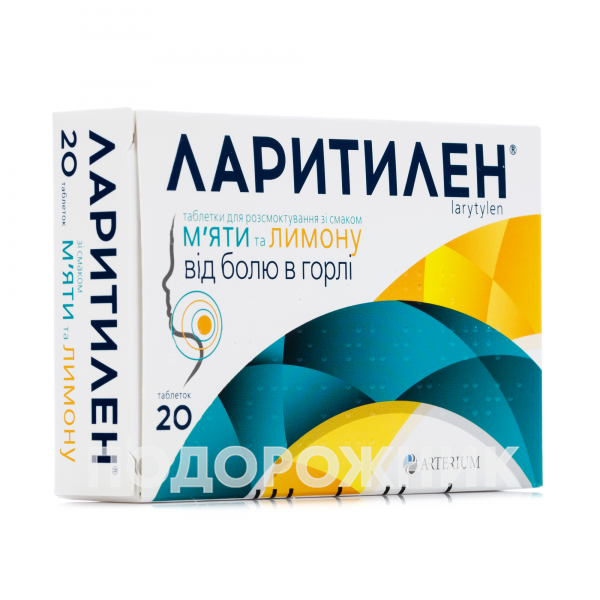

LARITILEN

Ask a doctor about a prescription for LARITILEN

How to use LARITILEN
INSTRUCTIONS for medical use of the medicinal product ALLERGODIL®(ALLERGODIL®)
Composition
active substance: azelastine hydrochloride; 1 ml of solution contains azelastine hydrochloride 1 mg; excipients: hypromellose, disodium edetate, anhydrous citric acid, sodium hydrogen phosphate, dodecahydrate, sodium chloride, purified water.
Pharmaceutical form
Nasal spray, dosed.
Main physical and chemical properties
Transparent colorless solution.
Pharmacotherapeutic group
Agents used in diseases of the nasal cavity. Antiallergic agents, excluding corticosteroids. ATC code R01A C03.
Pharmacological properties
Pharmacodynamics
Azelastine hydrochloride is an H1-receptor antagonist and, as a result, is an antiallergic substance with a relatively long half-life (t1/2 @ 20 hours).
In addition, in vivo studies in guinea pigs have shown that when used in therapeutic doses for humans, azelastine hydrochloride inhibits bronchial spasm caused by leukotrienes and platelet-activating factor (PAF) inhibitors.
Due to these properties, in animal experiments, azelastine hydrochloride is also able to inhibit inflammation in the airways caused by hypersensitivity reactions. The significance of the findings obtained in animal studies has not been clarified regarding the therapeutic application of the drug in humans.
Pharmacokinetics
Azelastine hydrochloride is quickly and almost completely absorbed after oral administration and is mainly distributed in peripheral organs, primarily in the lungs, skin, muscles, liver, and kidneys, and to a minor extent in the brain. Dose-dependent linear kinetics have been demonstrated. Azelastine hydrochloride and its metabolites are excreted approximately 75% with feces and approximately 25% by the kidneys. The most important metabolic pathways are hydroxylation of the ring, N-demethylation, and oxidative opening of the azepine ring.
In patients with allergic rhinitis, the steady-state average concentration of azelastine hydrochloride in plasma, observed 2 hours after administration of the total daily dose of 0.56 mg of azelastine hydrochloride (1 spray in each nostril 2 times a day), was approximately 0.65 ng/ml, but this did not lead to clinically significant systemic side effects.
As a result of the dose-dependent linear effect, an increase in average plasma levels can be expected with an increase in the daily dose.
Clinical characteristics
Indications
Symptomatic treatment of seasonal allergic rhinitis (hay fever) and non-seasonal (perennial) allergic rhinitis.
Contraindications
Increased sensitivity to the active substance, ethylenediaminetetraacetic acid (EDTA), or to any other component of the drug.
The drug is contraindicated in children under 6 years of age.
Interaction with other medicinal products and other types of interactions
So far, no interaction with other drugs has been detected.
Special warnings and precautions for use
None.
Use during pregnancy or breastfeeding
Clinical data on the use of azelastine hydrochloride in women during pregnancy or breastfeeding are absent. Studies in animals with high oral doses of azelastine led to embryo death, delayed development, and skeletal defects.
Therefore, it is not recommended to use the drug during pregnancy or breastfeeding.
Ability to influence the reaction rate when driving vehicles or operating other mechanisms
When using the drug, in individual cases, increased fatigue, exhaustion, fatigue, dizziness, or weakness may occur, which can also be caused by the disease itself. In these cases, the reaction rate when driving a vehicle or working with other mechanisms may be reduced. Special attention should be paid to the fact that these symptoms can be exacerbated by the simultaneous use of alcohol and other drugs that negatively affect the reaction rate.
Method of administration and dosage
For nasal use.
Unless otherwise prescribed, the spray should be administered 1 dose in each nostril 2 times a day (in the morning and evening; corresponds to a daily dose of azelastine hydrochloride 0.56 mg/day).
When using the spray, the head should be kept straight.
The duration of therapy depends on the type, severity, and development of symptoms and is determined by the doctor individually.
The drug can be used for long-term therapy.
Children
Can be used in children from 6 years of age.
Overdose
There is no experience with the use of toxic doses of azelastine hydrochloride in humans. In case of overdose or intoxication, central nervous system disorders are expected based on the results of experiments on animals. Treatment of these disorders should be symptomatic. There is no known antidote.
Side effects
Side effects that may occur during the use of azelastine hydrochloride are classified according to the following frequency: very often (≥ 1/10), often (≥ 1/100 – < 1/10), uncommon (≥ 1/1000 – <1/100), rare (≥ 1/10000 – < 1/1000), very rare (< 1/10000), unknown (cannot be determined from available data).
From the immune system: very rare – hypersensitivity reactions.
From the nervous system: often – dysgeusia (in case of incorrect use (head thrown back) may cause symptoms of a bitter taste in the mouth, which can cause nausea); very rare – dizziness.
From the respiratory system: uncommon – irritation of the nasal mucosa with inflammation after spraying (such as burning and itching), sneezing, and nasal bleeding.
From the gastrointestinal tract: rare – nausea.
General disorders: very rare – increased fatigue (feeling of fatigue and exhaustion), dizziness or weakness, which can also be caused by the disease itself.
From the skin: very rare – rash, itching, urticaria.
Also, reports of drowsiness, headache, and dry mouth have been reported in some patients.
Shelf life
3 years.
After opening the bottle, the drug should be used within 6 months.
Storage conditions
Store at a temperature not exceeding 25 °C. Do not cool. The drug should be stored in a place inaccessible to children.
Packaging
10 ml in a bottle with a screwed-on sprayer; 1 bottle in a cardboard box.
Release category
Without a prescription.
Manufacturer
Madaus GmbH / Madaus GmbH.
Location of the manufacturer and its address
Lutticher Strasse 5, 53842 Troisdorf, Germany / Lutticher Strasse 5, 53842 Troisdorf, Germany.
- Country of registration
- Prescription requiredNo
- Manufacturer
- This information is for reference only and does not constitute medical advice. Always consult a licensed doctor before taking any medication. Oladoctor is not responsible for medical decisions based on this content.
- Alternatives to LARITILENDosage form: lozenges, 12 lozenges in a blisterActive substance: variousManufacturer: Др. Тайсс Натурварен ГмбХPrescription not requiredDosage form: lozenges, 12 lozenges in a blisterActive substance: variousManufacturer: Др. Тайсс Натурварен ГмбХPrescription not requiredDosage form: lozenges, 12 lozenges in a blisterActive substance: variousManufacturer: Др. Тайсс Натурварен ГмбХPrescription not required
Online doctors for LARITILEN
Discuss dosage, side effects, interactions, contraindications, and prescription renewal for LARITILEN – subject to medical assessment and local rules.














